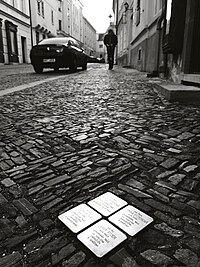Stolperstein

A stolperstein is a small, rectangular-shaped memorial that is placed on the ground in front of a building where a Jewish person or other victim of the Nazi regime once lived. They are meant to honor and remember the person who lived there and highlight their life and the tragedy of their fate.
These memorials are made out of brass and measure about 10 cm by 10 cm, which is about the size of your hand. They are engraved with the name of the person who lived there, their date of birth, the date they were taken away, and where they died. Sometimes they also have a brief message or quote from the person, such as a poem they wrote or something they said.
The word "stolperstein" is German for "stumbling block" because these memorials are meant to make people stop and think about the person whose name is engraved on them. They are also meant to make sure we never forget the Holocaust and the terrible things that happened during that time.
Stolpersteine are usually laid by artists or historians, and they are funded by individual donors or organizations. They are often placed in cities and towns all over Europe where Jewish people were forcibly removed from their homes and taken to concentration camps.
Overall, stolpersteine are a way to remember the people who lost their lives during the Holocaust and ensure that their memory is never forgotten.
These memorials are made out of brass and measure about 10 cm by 10 cm, which is about the size of your hand. They are engraved with the name of the person who lived there, their date of birth, the date they were taken away, and where they died. Sometimes they also have a brief message or quote from the person, such as a poem they wrote or something they said.
The word "stolperstein" is German for "stumbling block" because these memorials are meant to make people stop and think about the person whose name is engraved on them. They are also meant to make sure we never forget the Holocaust and the terrible things that happened during that time.
Stolpersteine are usually laid by artists or historians, and they are funded by individual donors or organizations. They are often placed in cities and towns all over Europe where Jewish people were forcibly removed from their homes and taken to concentration camps.
Overall, stolpersteine are a way to remember the people who lost their lives during the Holocaust and ensure that their memory is never forgotten.
Related topics others have asked about:
